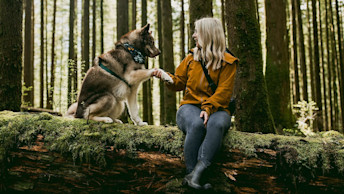August 19, 2022
How to Adjust to Back to School Time with Your Dog

Gulp… the end of summer is drawing nearer and that list of things you wanted to sort out regarding your dog’s behaviour is still looming. That’s okay – it is better late than never to finally take action to make sure your dog is ready for what is to come.
September is a time of transition… back to school, new beginnings and often new routines. This can be an exciting time for us and a rather stressful time for our beloved canine companions.
Most dogs thrive with some semblance of routine or predictability in their daily lives with us.
When we have big schedule changes, it can really throw your dog off and lead them to behave out of character or simply leave them feeling unsettled or anxious. No one wants that! An unhappy dog = an unhappy human!
Being aware of this, we can get our dogs prepped and primed in advance to ensure a smooth process for everyone this fall.
Here are some tips to ease your dog (and you) into this change of routine:
1. Get into a routine
Two weeks before back to school/work is in full swing, get into a routine that mimics what it will be like in September. This might mean waking up earlier and taking them for a morning walk, hustling and bustling out of the house the way you will if you are late, getting into a schedule with pee breaks and nap times. And most importantly, slowly increasing the length of time they are alone daily to normalize being isolated (if they are comfortable with that).
2. Hire a dog trainer
If your dog currently struggles to be left home alone, sooner rather than later, hire the help of a Certified Professional Positive Reinforcement Dog Trainer. Getting them used to being alone can take longer than you expect and is not always a straight forward process. Putting it off or hoping for the best if you know your dog is not comfortable solo at home might cause you and your pup more stress than necessary long term. This video on Sniffdog YouTube channel might be just what you need to get the ball rolling.
3. Get your dog used to being home alone
Getting your dog used to being home alone involves a number of training steps, one of which is desensitization. We accomplish this by normalizing your absence through multiple short exposures to you departing (I’m talking seconds or minutes here, people). The most important component of desensitization is to always return before your dog exhibits stress behaviours.
Stress behaviours include:
- Panting
- Pacing
- Vocalization
- Drooling
- Damaging exits or doorways
- Digging in the crate
- Self-harm
- Having accidents
If you see any of these behaviours, hire professional help!
Once your dog is comfortable with you coming and going for various durations, you can start to slowly increase the length of time they are left home alone, always observing on a camera or trying to return before they worry – we want them to think it is no big deal that you keep entering and exiting out of that doorway!
See what I mean? Putting this off until the week your schedule changes particularly for an anxious dog can be a LOT to ask of them! For some dogs it can take a long time for them to get used to you being gone longer than usual - here is your push to get started on this training stat, you can thank me later!
4. Keep them entertained
Your new routine might increase your dog’s general stress levels or require you to be a bit more creative with how to keep them entertained. Try increasing mental stimulation by using their daily ration of kibble (YUM!) to feed them from a dog puzzle, a frozen stuffed Kong, a Kong Wobbler, a Snoop toy, or a snuffle mat.

Offering chew items daily such as dog safe bones, yak chews or bully sticks can save them from chewing on your furniture of walls if they are getting a bit less exercise than usual (not unsupervised)! If you or your dog are not a fan of the puzzles or chews, try using that daily ration of kibble for engaging training games (more found on the YouTube channel).
Sniffing is also naturally calming to dogs – try taking a new walking route or veering off the beaten path to bring more fun and enrichment to your walk!
In Conclusion
Above all else, be patient with your dog (and yourself) if things are not perfect as you both transition into September! You might find that it takes both of you a few weeks to adjust and settle in.



